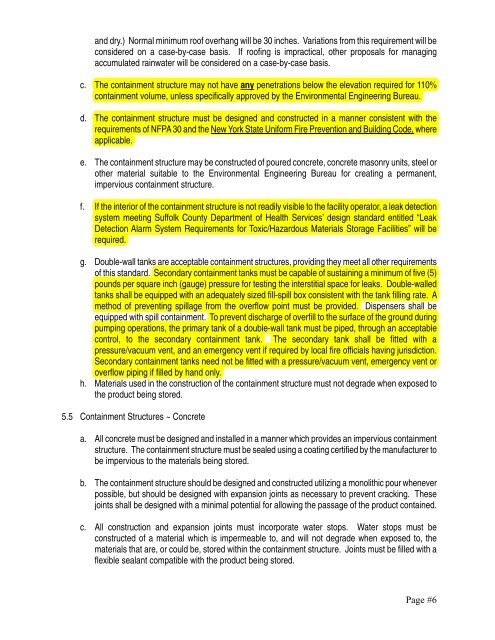Aboveground Tanks (Outdoors) - Guidelines - Brookhaven National ...
Aboveground Tanks (Outdoors) - Guidelines - Brookhaven National ...
Aboveground Tanks (Outdoors) - Guidelines - Brookhaven National ...
You also want an ePaper? Increase the reach of your titles
YUMPU automatically turns print PDFs into web optimized ePapers that Google loves.
and dry.) Normal minimum roof overhang will be 30 inches. Variations from this requirement will be<br />
considered on a case-by-case basis. If roofing is impractical, other proposals for managing<br />
accumulated rainwater will be considered on a case-by-case basis.<br />
c. The containment structure may not have any penetrations below the elevation required for 110%<br />
containment volume, unless specifically approved by the Environmental Engineering Bureau.<br />
d. The containment structure must be designed and constructed in a manner consistent with the<br />
requirements of NFPA 30 and the New York State Uniform Fire Prevention and Building Code, where<br />
applicable.<br />
e. The containment structure may be constructed of poured concrete, concrete masonry units, steel or<br />
other material suitable to the Environmental Engineering Bureau for creating a permanent,<br />
impervious containment structure.<br />
f. If the interior of the containment structure is not readily visible to the facility operator, a leak detection<br />
system meeting Suffolk County Department of Health Services’ design standard entitled “Leak<br />
Detection Alarm System Requirements for Toxic/Hazardous Materials Storage Facilities” will be<br />
required.<br />
g. Double-wall tanks are acceptable containment structures, providing they meet all other requirements<br />
of this standard. Secondary containment tanks must be capable of sustaining a minimum of five (5)<br />
pounds per square inch (gauge) pressure for testing the interstitial space for leaks. Double-walled<br />
tanks shall be equipped with an adequately sized fill-spill box consistent with the tank filling rate. A<br />
method of preventing spillage from the overflow point must be provided. Dispensers shall be<br />
equipped with spill containment. To prevent discharge of overfill to the surface of the ground during<br />
pumping operations, the primary tank of a double-wall tank must be piped, through an acceptable<br />
control, to the secondary containment tank. The secondary tank shall be fitted with a<br />
pressure/vacuum vent, and an emergency vent if required by local fire officials having jurisdiction.<br />
Secondary containment tanks need not be fitted with a pressure/vacuum vent, emergency vent or<br />
overflow piping if filled by hand only.<br />
h. Materials used in the construction of the containment structure must not degrade when exposed to<br />
the product being stored.<br />
5.5 Containment Structures ~ Concrete<br />
a. All concrete must be designed and installed in a manner which provides an impervious containment<br />
structure. The containment structure must be sealed using a coating certified by the manufacturer to<br />
be impervious to the materials being stored.<br />
b. The containment structure should be designed and constructed utilizing a monolithic pour whenever<br />
possible, but should be designed with expansion joints as necessary to prevent cracking. These<br />
joints shall be designed with a minimal potential for allowing the passage of the product contained.<br />
c. All construction and expansion joints must incorporate water stops. Water stops must be<br />
constructed of a material which is impermeable to, and will not degrade when exposed to, the<br />
materials that are, or could be, stored within the containment structure. Joints must be filled with a<br />
flexible sealant compatible with the product being stored.<br />
Page #6
















